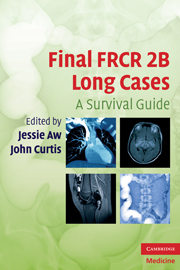Introduction
Published online by Cambridge University Press: 06 July 2010
Summary
FRCR Examination Part 2B
The final examination of the Fellowship of the Royal College of Radiologists (part 2B) comprises several components:
A rapid reporting session
A reporting session (or known amongst trainees as the ‘Long Cases’)
An oral examination
This guide-book will only concentrate on the reporting session. You may find the structure useful as a basis for future reporting in your practice if you so wish.
What does the reporting session consist of?
Currently it consists of:
Six cases, on ‘hard copy’ film. In April 2010 for those sitting the examination in the UK, the Royal College of Radiologists will conduct this part of the examination and the rapid reporting section using a digital format. The viva section of the examination is likely to be in digital format in 2012. Please keep updated by visiting the Royal College website at http://www.rcr.ac.uk
A total of 45 minutes is provided to complete writing all your answers in the booklet provided
The cases may include plain radiographs, ultrasound, radionuclide imaging, CT and MR imaging. The cases may include a mixture of cases from all the six modules with varying degrees of complexity and difficulty. Any type of the stated radiological imaging can occur and often the case can involve more than one imaging modality, e.g. a case can comprise a plain radiograph and further investigations, for example CT and radionuclide imaging. Currently the Royal College of Radiologists has not yet stated that PET or PET-CT will be included.
- Type
- Chapter
- Information
- Final FRCR 2B Long CasesA Survival Guide, pp. 1 - 8Publisher: Cambridge University PressPrint publication year: 2010

